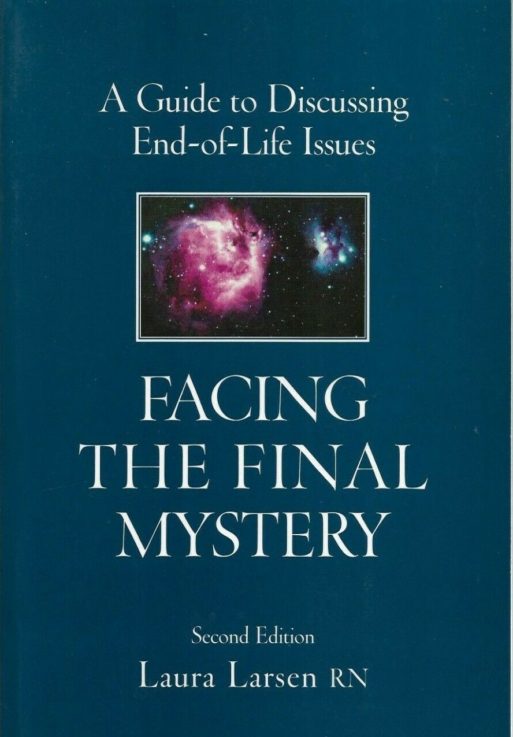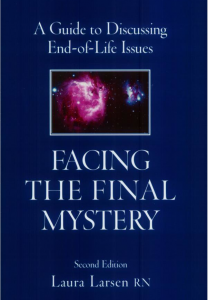 Facing The Final Mystery is by no means a book you read in a few sittings — nor does it simply live on your bookshelf. Larsen’s book is more of a consulting manual, especially regarding problems that are unique to individual situations. The book promotes palliative care and explores the nature of hospice care. Specifically, she explains the process of obtaining hospice care in the event that it is necessary.
Facing The Final Mystery is by no means a book you read in a few sittings — nor does it simply live on your bookshelf. Larsen’s book is more of a consulting manual, especially regarding problems that are unique to individual situations. The book promotes palliative care and explores the nature of hospice care. Specifically, she explains the process of obtaining hospice care in the event that it is necessary.
Larsen combines her personal experiences with stories from other families, especially in the various ways they deal with a loss. She mixes in quotes from famous writers such as Leo Tolstoy, and draws on the work of industry pioneer Elizabeth Kubler-Ross. She discusses the difficulties relatives face when a loved one dies. Larsen also opens up the discussion on the difficulties we can create for ourselves and our future if we choose to ignore our inevitable death.
Many of our fears about death and dying can be very specific — and Larsen knows this. For example, in chapters four and five she discusses the bioethical dilemmas related to end-of-life planning. How do we decide to keep an individual alive with the help of technology should their heart stop? Countless medical and financial issues are discussed in chapters six through nine, where readers learn what services are available to them. Larsen understands that the practical, financial arrangements of a dying individual and their family are crucial to feeling comfortable with end-of-life thoughts.
 The book raises many interesting questions — although it doesn’t always offer as many clear-cut, issue-specific-solutions as readers would like. Nevertheless, it forces the reader to wonder about important questions in the context of their position in life. Readers must think about the decisions they will make regarding their own end-of-life arrangements. The underlying goal of Larsen’s book is to make us consider such planning in our own lifetime. In this way, we open up the conversation on death and dying. We can even, says Larsen, use art and poetry to heal.
The book raises many interesting questions — although it doesn’t always offer as many clear-cut, issue-specific-solutions as readers would like. Nevertheless, it forces the reader to wonder about important questions in the context of their position in life. Readers must think about the decisions they will make regarding their own end-of-life arrangements. The underlying goal of Larsen’s book is to make us consider such planning in our own lifetime. In this way, we open up the conversation on death and dying. We can even, says Larsen, use art and poetry to heal.
Facing the Final Mystery is a solid recorded effort to bring the final taboo, death, into our home conversations. When we can discuss death and dying at home, it becomes easier for family members to start end-of-life planning. Dealing with dying, terminal illness and bereavement will never be easy. But discussing the mystery of death as soon as possible renders it more “comfortable,” especially given the endless information, services and technology that are available to us.
Death and dying are very difficult topics to speak about, although our understanding of the two has evolved tremendously over the years. Today, we can truly map out our end-of-life experience in a fashion that — at least from the book’s point of view — makes our ‘exit’ more comfortable for us. Such planning can be crucial for those suffering from a terminal illness during their dying process. Planning can also relieve a family of the complicated issues that may arise after the passing of a loved one.
“Facing the Final Mystery is a solid recorded effort to bring the final taboo, death, into our home conversations”
Larsen offers us many helpful exercises: “Feeling, Not Thinking,” “Writing Without Editing” and “Expressing Feelings Through Art” are all tools she explores with her audience. Larsen is confident that these exercises will “help [readers] consider the contents of [their] unacknowledged and unexpressed emotions.” Our goal should be to transfer our energy to various areas, to make it “available for focused relationships, including death and dying, creativity, good health and the ability to care for ourselves and others in need.”
Other Book Reviews:

 ”Facing the Final Mystery: A Guide to Discussing End-of-Life Issues” by Laura Larsen, RN
”Facing the Final Mystery: A Guide to Discussing End-of-Life Issues” by Laura Larsen, RN


 How Dare You Die Now!
How Dare You Die Now!
 Debating Medical Aid in Dying
Debating Medical Aid in Dying
 “Help Me, Helen”
“Help Me, Helen”














